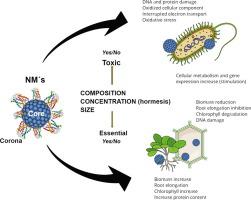Journal of Advanced Research ( IF 11.4 ) Pub Date : 2021-01-05 , DOI: 10.1016/j.jare.2020.12.011 Antonio Juárez-Maldonado 1 , Gonzalo Tortella 2 , Olga Rubilar 2 , Paola Fincheira 2 , Adalberto Benavides-Mendoza 3

|
Background
Biostimulation and toxicity constitute the continuous response spectrum of a biological organism against physicochemical or biological factors. Among the environmental agents capable of inducing biostimulation or toxicity are nanomaterials. On the < 100 nm scale, nanomaterials impose both physical effects resulting from the core’s and corona’s surface properties, and chemical effects related to the core’s composition and the corona’s functional groups.
Aim of Review
The purpose of this review is to describe the impact of nanomaterials on microorganisms and plants, considering two of the most studied physical and chemical properties: size and concentration.
Key Scientific Concepts of Review
Using a graphical analysis, the presence of a continuous biostimulation-toxicity spectrum is shown considering different biological responses. In microorganisms, the results showed high susceptibility to nanomaterials. Simultaneously, in plants, a hormetic response was found related to nanomaterials concentration and, in a few cases, a positive response in the smaller nanomaterials when these were applied at a higher level. With the above, it is concluded that: (1) microorganisms are more susceptible to nanomaterials than plants, (2) practically all nanomaterials seem to induce responses from biostimulation to toxicity in plants, and (3) the kind of response observed will depend in a complex way on the nanomateriaĺs physical and chemical characteristics, of the biological species with which they interact, and of the form and route of application and on the nature of the medium -soil, soil pore water, and biological surfaces- where the interaction occurs.
中文翻译:

生物刺激和毒性:纳米材料对微生物和植物的影响程度
背景
生物刺激和毒性构成了生物有机体对物理化学或生物因素的连续反应谱。能够诱导生物刺激或毒性的环境物质包括纳米材料。在 < 100 nm 尺度上,纳米材料会施加由核心和电晕表面特性引起的物理效应,以及与核心成分和电晕官能团相关的化学效应。
审查目的
本综述的目的是描述纳米材料对微生物和植物的影响,考虑到两个研究最多的物理和化学特性:尺寸和浓度。
审查的关键科学概念
使用图形分析,考虑到不同的生物反应,显示了连续生物刺激毒性谱的存在。在微生物中,结果显示对纳米材料的高度敏感性。同时,在植物中,发现与纳米材料浓度有关的激素反应,在少数情况下,当以较高水平应用较小的纳米材料时,会产生积极的反应。综上所述,得出的结论是:(1)微生物比植物更容易受到纳米材料的影响,(2)实际上所有纳米材料似乎都会诱导植物对生物刺激的反应,以及(3)观察到的反应类型将取决于纳米材料物理和化学特性的复杂方式,与它们相互作用的生物物种,









































 京公网安备 11010802027423号
京公网安备 11010802027423号